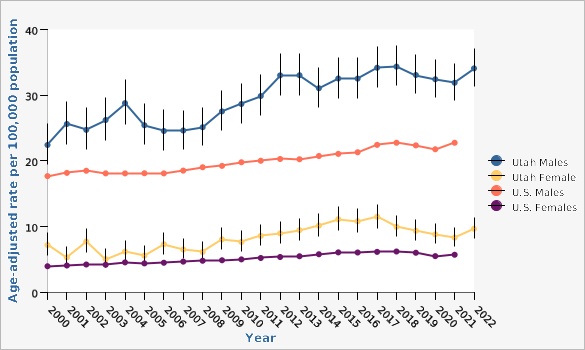Why Is This Important?
From 2020 to 2022, the age-adjusted suicide rate in Utah was 20.85 per 100,000 persons, with an average of 670 suicides per year. There were 717 suicide deaths in 2022.
In 2022, suicide was the leading cause of death for Utahns ages 10 to 17 and 18-24. It was the second leading cause of death for ages 25 to 44 and the fifth leading cause of death for ages 45-64. Overall, suicide was the tenth leading cause of death for Utahns (age-adjusted rate).
Suicide deaths are only part of the problem. More people are hospitalized or treated in emergency rooms for suicide attempts than are fatally injured. In 2022, 12 Utahns were treated for self-inflicted injuries every day (3,121 treat-and-release emergency department visits plus 1,311 total hospitalizations).
According to the 2021 Youth Risk Behavior Survey, in the 12 months preceding the survey, Utah high school students reported the following: 41.5% felt sad or hopeless, 22.5% seriously considered attempting suicide, 18% made a suicide plan, 9% attempted suicide one or more times, and 2.7% had a suicide attempt that required medical attention.
The 2023 Prevention Needs Assessment data indicate that overall, 27% of Utah students in grades 8, 10, and 12 reported experiencing serious mental illness. Students were also asked social isolation questions and reported the following: 14.2% felt moderately socially isolated and 9.2% felt severely socially isolated. Additionally, 7.3% reported having attempted suicide in the past year and 18.9% reported having seriously considered attempting suicide in the past year.
All suicide attempts should be taken seriously. Suicide attempt survivors are often seriously injured, are likely to have depression and/or another mental health disorder, and are at an increased risk for suicide.
Suicidal behavior is a serious and complex public health issue that takes an enormous toll on communities with both economical and human costs.Suicide by sex and year, Utah 2000-2022 and U.S. 2000-2021 |
Data Sources
- Utah Death Certificate Database, Office of Vital Records and Statistics, Utah Department of Health and Human Services
- For years 2020 and later, the population estimates are provided by the Kem C. Gardner Policy Institute, Utah state and county annual population estimates are by single year of age and sex, IBIS Version 2022
- Population Estimates for 2000-2019: National Center for Health Statistics (NCHS) through a collaborative agreement with the U.S. Census Bureau, IBIS Version 2020
- National Center for Injury Prevention and Control's Web-based Injury Statistics Query and Reporting System (WISQARS)
Data Notes
Suicides are determined using ICD-10 codes X60-X84, Y87.0, *U03.Risk Factors
Many conditions and stressors may be related to suicide including:
*Previous suicide attempt(s)
*History of depression or other mental illness
*Alcohol or drug abuse
*Family history of suicide or violence
*Physical illness
*Easy access to lethal means of suicide[[br]]
[[br]]
Source: [https://www.cdc.gov/suicide/factors/index.html] (accessed 12/28/2023)How Are We Doing?
The 2022 Utah age-adjusted suicide rate was 21.9 per 100,000 population. Males (34.1 per 100,000 population) had a significantly higher age-adjusted suicide rate compared to females (9.7 per 100,000 population).
In Utah from 2020 to 2022, males had significantly higher suicide rates than females in every age group. Males aged 45-54 had the highest suicide rates among males (49 per 100,000 population). Females aged 45-54 had the highest suicide rates among female age groups (18.1 per 100,000 population).
From 2020 to 2022, TriCounty, Central Utah, Southwest, and Weber-Morgan local health districts had significantly higher age-adjusted suicide rates compared to the state rate.
Among Utah Small Areas, Duchesne County, Central (Other), South Salt Lake, Southwest LHD (Other), Daggett and Uintah County, and Salt Lake City (Downtown) had significantly higher age-adjusted suicide rates compared to the state rate during 2018-2022.What Is Being Done?
The Utah Department of Health and Human Services Violence and Injury Prevention Program (VIPP) is funded by the U.S. Centers for Disease Control and Prevention (CDC) to implement the Utah Violent Death Reporting System (UTVDRS). UTVDRS is a data collection and monitoring system that will help Utahns to better understand the public health problem of violence by informing decision-makers about the magnitude, trends, and characteristics of violent deaths such as suicide, and to evaluate and continue to improve state-based violence prevention policies and programs. Data are collected from the Office of the Medical Examiner, Vital Records, and law enforcement agencies and are linked together to help identify risk factors, understand circumstances, and better characterize perpetrators of violent deaths.
The VIPP is also funded by the CDC to improve the timeliness of syndromic surveillance data of nonfatal suicide-related outcomes, including nonfatal self-directed violence and suicidal ideation.
The VIPP partners with multiple state and local agencies including the Division of Substance and Mental Health (DSAMH), the Utah State Board of Education, the Office of the Medical Examiner, the National Alliance on Mental Illness Utah, local health departments, and many others to facilitate and build capacity for suicide prevention efforts across the state. VIPP also participates in the Utah Suicide Prevention Coalition, a state-level multi-sectoral group, and its seven workgroups that focus on specific populations and topic areas.
Date Indicator Content Last Updated: 03/05/2024
Other Views
- by sex and year, Utah 2000-2022 and U.S. 2000-2021
- by Local Health District, Utah 2020-2022 and U.S. 2019-2021
- by Utah Small Area, 2018-2022
- by age group and sex, Utah, 2020-2022
- by method of injury and sex, Utah, 2013-2022
- by race, Utah, 2020-2022
- by ethnicity, Utah, 2020-2022
- risk among high school students by risk factor and sex, Utah, 2021
- attempts reported by students in grades 9-12, Utah and U.S., 1999-2021
- plan reported by students in grades 9-12, Utah and U.S., 1999-2021

